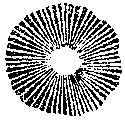


Some plants and fungi are endangered and/or protected. Make absolutely certain before you harvest any green plant, fungus or lichen that it is okay to do so.
Leaves, stems and flowers that are not too thick are best for pressing. Always make certain that you are not picking leaves or flowers from species that are protected. To make a press, start with two thin but sturdy pieces of wood that are larger than the plants you will be pressing. On the bottom of one, nail two leather straps or old belts. Or you can simply use two pieces of light rope to bind the press together. Layer sheets of cardboard and newspaper between the wooden boards. Place the plants between the newspaper sheets, binding the whole thing together each time you do so. Whenever known, make a note of the type of plant when it is collected. If you only have a few plants to press, you can do so simply by placing them between sheets of newspaper and weighting them for a few days. It is best to change the newspapers each day until the plant is thoroughly dry. You can display the dried and labeled plants on a sheet of heavy paper by gluing or taping them down (spots of rubber cement work well), or you can laminate them between plastic, which will keep insects away from them.
Some of the more stout leaves, such as holly, magnolia, and some of the maples, can be preserved without flattening them by using glycerin, which is still readily available in many pharmacies. By trial and error you can determine which types of leaves work best by this method. The leaves used should be very fresh. Add 2 parts boiling water to 1 part glycerin. Place the leaf in the warm glycerin solution so that its petiole (stem) is submerged 3-4 inches (7-10 cm). How long the process takes depends on the type of leaf, but you will know enough has been absorbed when drops of glycerin appear on the surface of the leaf. Remove the leaf from the solution and wipe to remove any excess. Drain on thick stacks of newspaper for a few days, then wash (not too rough!) with a little soap and water. Hang on a line (wooden clothespins are useful here) to dry.
You can capture fall colors in leaves fairly well using this method. Pick the leaves just as they are turning. If they have completely turned or have fallen from the tree they probably won't absorb much of the glycerin solution. You can also preserve branches (twiglets and leaves) fairly well, but it will require quite a bit of glycerin, so it may be cost prohibitive. If you do want to try a small branch, the entire thing needs to be immersed in a warm solution of 1 part glycerin to 1 part water. Leave it in for at least double the time that it takes for one leaf from the same plant to complete using the single leaf method.
To preserve the shape of flowers, pour an inch or so of borax into the bottom of a small cardboard box. Sturdy flowers work best for this. Set the cut flowers, stem side down, into the borax. Slowly and carefully cover the flowers with more borax, and set the box in a sunny place for 2 or 3 weeks (delicate flowers dry faster - a week or so). Carefully pour off the borax and save for the next drying. The flowers will be fragile, but the shape and much of the color should be preserved. Fine white sand can be substituted if borax can't be found.
 Leaf prints are a good way of making a record of the size and shapes of leaves of various trees. First, collect a leaf or two from a specific tree. Identify the tree whenever possible and not this with the leaves. The leaves chosen should be as free from holes and tears as possible. It is better (for the tree anyway) if you can find good leaves that have fallen from the tree. Place the leaves in a press (several thickness of newspapers topped with a weight) to flatten. This should only take a day or two, depending on the thickness of the leaf. Prepare a workspace by covering a table with newspapers. Pour some colored ink into a small dish, and dip an old toothbrush into the ink. Practice making spatters by scraping a short stick toward you (not away) through the bristles. This causes the ink to spatter away from you. You can also run the toothbrush over a fine mesh screen held over the leaf. Practice until you can get a fine, controlled spatter. Place the leaf onto a piece of art paper and spatter around the edges of the leaf.
Leaf prints are a good way of making a record of the size and shapes of leaves of various trees. First, collect a leaf or two from a specific tree. Identify the tree whenever possible and not this with the leaves. The leaves chosen should be as free from holes and tears as possible. It is better (for the tree anyway) if you can find good leaves that have fallen from the tree. Place the leaves in a press (several thickness of newspapers topped with a weight) to flatten. This should only take a day or two, depending on the thickness of the leaf. Prepare a workspace by covering a table with newspapers. Pour some colored ink into a small dish, and dip an old toothbrush into the ink. Practice making spatters by scraping a short stick toward you (not away) through the bristles. This causes the ink to spatter away from you. You can also run the toothbrush over a fine mesh screen held over the leaf. Practice until you can get a fine, controlled spatter. Place the leaf onto a piece of art paper and spatter around the edges of the leaf.
Cover the side of a smooth, round bottle with a thin layer of grease or Vaseline. Fill it with cold water and cap tightly. Hold it over a candle flame, spinning it, until it is covered with an even layer of soot. Place a leaf, vein side up, on a piece of newspaper. Roll the soot-covered bottle over the leaf, then move the leaf to a clean newspaper, soot side up. Cover it with a sheet of white paper and roll with a clean bottle or rubber roller. You can make the print smudge resistant by spraying it with an artist's fixative coating.
You can "skeletonize" a fresh leaf, green to expose the lacy pattern of veins it uses to transport food. Make a beating board by tacking an old piece of carpet or a thick rag to a board. Use an old shoe brush or hairbrush. The type of brush chosen is very important. It should be fairly fine but not stiff. Most synthetic brushes are too harsh. Once an appropriate brush has been located, place the leaf, top side up, on the beating board. Hold the leaf firmly in place and tap lightly until all of the fleshy part is gone. Occasionally, you will need to turn the leaf to the back side to tap it with the brush. Once the leaf has been skeletonized, you can display it in a scrapbook by gluing it to a piece of paper with a few small dabs of glue. Cover with cellophane. A nicer display can be made by sandwiching the leaf "skeleton" between two same-size pieces of glass sealed at the edges with adhesive tape.
 Mushrooms are a fungus and have no chlorophyll. They must get their food from whatever they are growing on. They also have no seeds, and reproduce by means of spores. The spores of a mushroom are located in the gills under the cap. You can make a print of the mushroom using its spores. Each print will be unique to the species of mushroom. Remember when handling mushrooms that many of them are poisonous and some can make you very sick or even kill you if you eat even a tiny bit. Unless you are an expert never eat any mushrooms you find in the wild. Wash your hands after handling any wild mushroom. To make a print, first choose a mushroom with an open cap and exposed gills. Ordinary grocery store variety mushrooms work fine. It should be fairly fresh. Identify the mushroom using a field guide if you are able so that you can label the print later. Remove the cap from the stem. Choose an appropriate piece of paper; dark paper if the spores are light, and light paper they are dark. Place the cap on the paper, gills down. Cover it with a dish so that the spores will not be carried away by air currents and leave it overnight. When the cap is removed, there will be a spore print on the paper.
Mushrooms are a fungus and have no chlorophyll. They must get their food from whatever they are growing on. They also have no seeds, and reproduce by means of spores. The spores of a mushroom are located in the gills under the cap. You can make a print of the mushroom using its spores. Each print will be unique to the species of mushroom. Remember when handling mushrooms that many of them are poisonous and some can make you very sick or even kill you if you eat even a tiny bit. Unless you are an expert never eat any mushrooms you find in the wild. Wash your hands after handling any wild mushroom. To make a print, first choose a mushroom with an open cap and exposed gills. Ordinary grocery store variety mushrooms work fine. It should be fairly fresh. Identify the mushroom using a field guide if you are able so that you can label the print later. Remove the cap from the stem. Choose an appropriate piece of paper; dark paper if the spores are light, and light paper they are dark. Place the cap on the paper, gills down. Cover it with a dish so that the spores will not be carried away by air currents and leave it overnight. When the cap is removed, there will be a spore print on the paper.
To make the print more permanent, The paper will need to be covered with a thin coating of gum arabic, which is available from most art supply stores. Spread this thinly over the paper. Three toothpicks will need to be pushed through the mushroom cap so that it sits, tripod style, just barely above the paper. Mucilage can be substituted for the gum arabic if it is allowed to nearly dry, but it does not work quite as well. Egg whites will also work if spread thinly.

This article was printed from the Bizarre Labs website at bizarrelabs.com